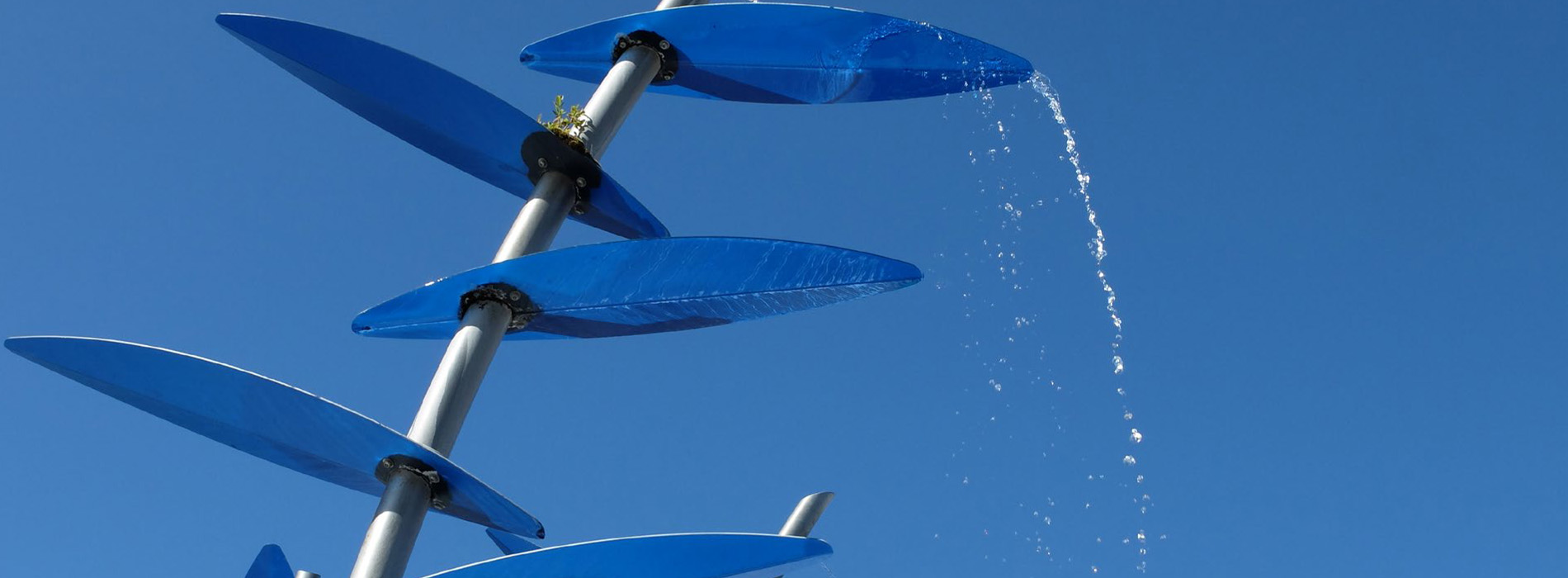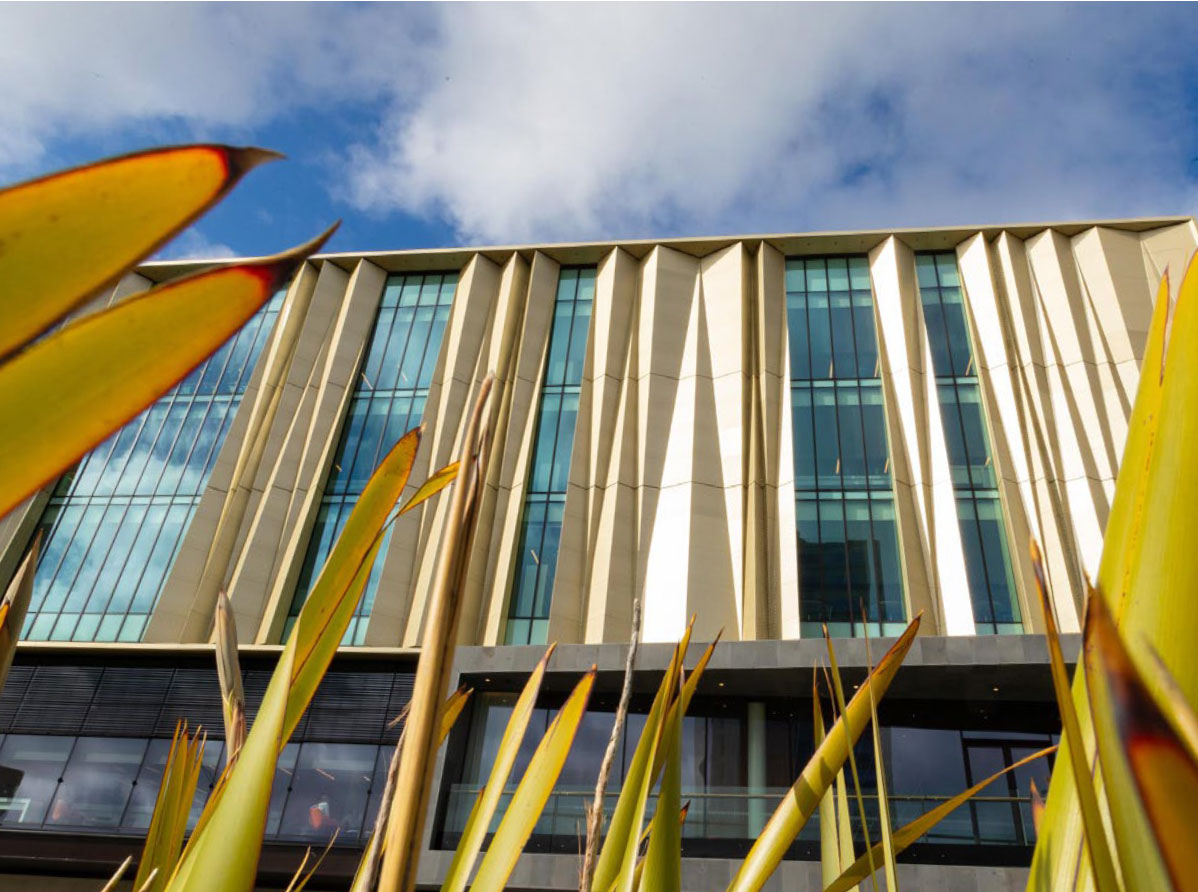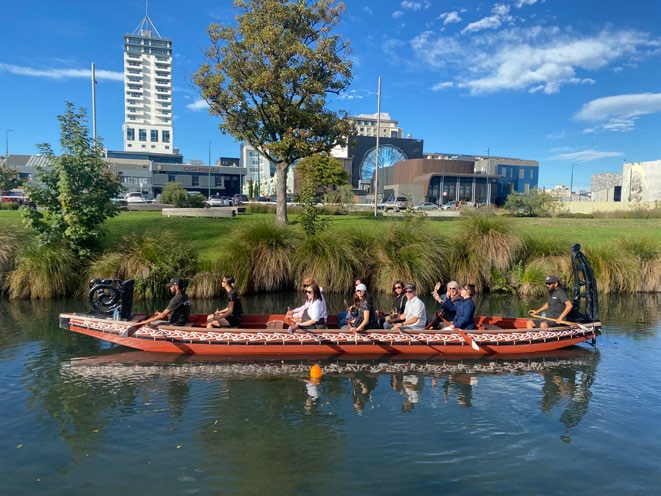
Culture Etc.

The water play area at the Margaret Mahy Playground provides interaction — damming devices, taps to turn on and off, drills to spin.
Building Joy
Christchurch, the “Garden City”, was long thought of as pretty and just a bit old-fashioned. Then came the earthquake, and it became the ruined city. Today, the city centre is buzzing.
By Gabi Lardies
You can hear it before you see it. The sun shines crisply and as the Ōtākaro/Avon River sparkles under great oak trees, a choir of children gleefully scream. On this, and all, weekends, the Margaret Mahy Family Playground is absolutely heaving. In Christchurch’s city centre, what’s thought to be the largest playground in the Southern Hemisphere sprays, loops, twists, spins, echoes, pulls, shades and bounces. There are flying foxes, a water park, a sand pit, climbing nets, a giant slide, a climbing slope, inset trampolines and giant orange flowers laying their shadows over it all.
At its opening in December 2015, hundreds of balloons were released into the sky, live music played, clowns clowned and stilt walkers roamed the area. But apart from these colourful characters, it was Earthquake Recovery Minister Gerry Brownlee who officially opened the playground. Before the 2011 earthquake, the site was home to the Centennial Pool, an office building, the Bohemian Bar and a community health clinic. It cost $1.3 million to demolish and clear what was left of them. As the children played on that first day almost eight years ago, watching adults were teary.
In about 10 seconds, the fatal 2011 earthquake changed Christchurch forever. It claimed 185 lives; much of the city centre fell or had to be demolished. The destruction came to define the city. Today, the names of those who died are carved in marble at a curve in the Avon. Most of the city centre has been rebuilt. Grief is like that. It never diminishes, but life continues to grow around it so that it is not all-consuming. At the centre of the city, the Christ Church Cathedral stands, half destroyed. As the city tour tram goes by, the conductor says over the loudspeaker, “The Cathedral is the heart of Christchurch, always has been, and always will be.” At the moment, this heart has 408 tonnes of steel holding it up.
The playground is part of a recovery plan which has also thrown up a new central library, Tūranga; a convention centre, Te Pae; and retail, health and innovation precincts. From the rubble, a new city is emerging. The city has been rebuilt with bold colours, international architects and a seemingly utopic desire for joy. The playground came under fire less than a week after its opening for its price tag — $40.9 million. The playground equipment cost $3 million; developing the site (earthworks, paving and landscaping), $17 million; purchasing the land, $19.6 million; and clearing it, $1.3 million. The cost raised some eyebrows, with one community rebuild advocate claiming to be “gobsmacked” by the cost of this single initiative. Perhaps, after disaster, investing in play can seem frivolous.
It appears though, that people like well-made things, love playing, and that the playground has returned many bangs (on little knees, elbows, and fingers) for its bucks. Visitors to the Margaret Mahy playground vary in height from about half a metre to almost two. Some toddle on the grass under watchful eyes, some of the taller ones zip past on bikes, some sit on the steps by the river discussing the happenings of the day, others knit at the picnic tables, or turn sausages on the coin-operated barbecues. For the less-organised there are food trucks with loaded chips, coffee and ice cream. The structure of the climbing nets resembles a beehive — and there’s a kid in every segment.

Kids delight in changing water pressure — which may unexpectedly splash them, or better still, adults.

Twenty Seven Steps, a popular spot from which to enjoy the street’s evening illumination.
For those not content with watching, relaxing or eating and without children to provide an excuse for climbing, spraying, sliding and swinging on the packed playground, fear not. After sunset, when kids are happily tucked in and sleeping, the playground is lit up. It’s a well-frequented spot for those wandering home from the pub or taking evening strolls. Night-time use is welcomed — it’s thought to keep vandalism at bay and serves more people — kids of all heights and ages.
The playground isn’t the only colourful setting for grown-up fun in the city. Just a five-minute walk away, the facades of a pedestrianised street are painted in alternating pastels: pink, green, blue, yellow. New Regent St was designed as a coherent whole in the Spanish Mission architectural style in the early 1930s, and is today a Category 1 Heritage area. At a little round iron table, a local sipping on a glass of sav says, “It’s beautiful, but we didn’t appreciate it before.” The little street escaped the worst of earthquake damage and does have the feeling of having recently been rediscovered and dusted off. The terraced facades on the first storey have remained relatively untouched, and feature shaped gables, arched windows, barley twist columns and patterned tiles from Majorca. Locals claim it’s the only “mirrored” street in the country, with the facades reflecting each other across the street. When feeling bold, perhaps after a couple more glasses of sav, they also claim it to be New Zealand’s most beautiful street.
By day, parasols shade café tables, and plenty of locals and visitors amble past the quirky businesses and boutiques. There’s the Rowena Watson Jewellers, which has, since the earthquake, focused solely on work made locally. A few doors down, the AV Club’s front window bears, in chunky 1970s style lettering, the words “Middle Earth Records” — a detail left over from a film shoot. Inside, it stocks retro arcade games, vintage records and plenty of Mario Kart cartridges for Nintendo consoles. In other shops you can get tattoos, funky eyewear, piercings, a manipedi, a new hairstyle or diamonds. A new venture is rumoured to be on its way: a laundromat-cum-wine bar.
One of the street’s original features was a lighting system with 400 lamps. When they were first turned on in 1932, hundreds of people came to see them. Today, some still light the street as bars and restaurants take over from shops and cafés. Here hospitality is booming. At number 16, you will find the simply named Downstairs bar, a cosy drinking den with an oldworld atmosphere. The drinks list, scrawled on a blackboard, boasts a mix of local and international wine. It would make sense, of course, to try something from Waipara, the wine region just 45 minutes away. Sheltered by the Teviotdale Hills, it has a reputation for sustainability, due to the collaborative efforts of local winemakers. On a wine list, look out for Pegasus Bay, The Hermit Ram, and Huntress, especially in the Riesling and Pinot Noir sections.
To fill your tummy, head upstairs to the aptly named Twenty Seven Steps. The restaurant showcases locally sourced seasonal ingredients, from oysters, to mackerel, to lamb, pumpkins and beans. It’s a place where details are important — right down to the mis-matched vintage bread plates: polka dots, florals and golden edges. The dishes on offer are thoughtfully put together, focusing on the combination of elements rather than fussy arrangements, though there is still an edible flower or two. The modern renditions of European styles don’t comprise on portion sizes, as beautifully presented food is sometimes wont to do. The risotto is delicious, if you can pass on the fresh seafood. Twenty Seven Steps is a local favourite so be sure to book ahead. If you can, choose a table by the window, as it’s the perfect vantage point to enjoy the street’s façades, which by night are brightly lit.
New Regent St has conserved a muted, vintage style, but since the earthquake, much of Christchurch has become new and shiny. Glass, along with timber, is a material which can flex more than stone or brick, and so withstands more movement. In the glass, the old stone buildings are reflected, warped and sliced by different panels.
One shiny new building is Tūranga, the central library. Its design was inspired by the angular leaves of harakeke, and the warm colours and shadows of the nearby Port Hills. Inside, the services and space reimagine what a library can provide for a community. On one sunny Sunday afternoon in March, it’s a lot more than books. On the ground floor, a chess club gathers around five games, lined up on a long table. Nearby, someone is working on a puzzle, and a man in a bucket hat reads the newspaper. On three huge touch screens a group of friends discover histories of the city through an interactive digital collage. The clattering of plates from the café mixes with the thuds of children climbing the oversized staircase, which leads to Imagination Station, a play area. Levels two and three are quieter — a student types on her laptop, people sit at soft low chairs with books, or use the computer labs. On level four, rooftop terraces look toward Maungatere (Mt Grey), the cathedral, and the Southern Alps. These are wonderful views in, and of, the city.

The design of Tūranga, left, is inspired by Canterbury’s natural environment.

Hoe are primarily a paddle but can double as a weapon if the need arises.
For a long time, Christchurch had a reputation of being conservative, very English, perhaps a bit boring. Its claim of being the “Garden City” dates back to 1906, when it hosted the New Zealand International Exhibition. A visiting British government official declared it so, as it reminded him of garden cities in England. The city held onto the phrase, and emphasised its central cathedral and other Gothic Revival buildings to attract tourists. Once, the quintessential tourist activity was punting on the Avon. While punts are still being offered from white-and-green-striped heritage boat sheds, they are now rivalled by waka.
Downtown, opposite Victoria Square, the team at Waka on Avon greet their visitors with a mihi. The team is dominated by rangitahi Māori who have been schooled though kura kaupapa Māori and have a firm grip on their cultural traditions and values. In a succinct summary, they explain the value of the area in pre-European times as a place to gather food and resources such as tī kōuka (cabbage tree) fibre. On the riverbank, white-tipped red hoe (paddles) are lined up on the grass. When everyone has picked one, the training exercises begin. Five paddling commands are taught. Once the paddlers-to-be have mastered holding the paddle up, bringing it down, tilting it at 45 degrees then swooping it down, they are ready.
The single-hulled waka, “Pohomare Koroheke, but you can call it Jimi,”&waits on the water. Painted red, white and black, it’s a collaboration between boat builder Jimi Brennan and master carver John Rua. Once all are on board, the kaiārahi (skipper) instructs the paddlers to begin. Between each stroke through the water, the hoe must be thunked against the rim of the waka, a pause and sound which creates the timing and rhythm for the group, ensuring they are synchronised. It is possible for the less coordinated to accidentally hit another’s hoe or splash each other, but the guide assures that “the waka hasn’t ever flipped . . . yet.” Should anyone fall out, the river is, in most areas, about thigh-high, “so you can walk over to the bank”.
Single-hulled waka were an important mode of transport in the early days of the city, when there were few roads and much swamp. Māori and settlers collaborated to transport trading goods and equipment along the river. Though waka are hardly new, the experience — vibrant, participatory, and playful — makes punting feel stuffy in comparison.
The duality of the boating experiences is echoed throughout the city. New Regent St is named after London’s Regent St, whereas the name of the new library, Tūranga, refers to the homeland of the Ngāi Tahu ancestor, Paikea, who made his way to Aotearoa on the back of a whale (stopping on the east cape of Te Ika-a-Māui before travelling further south). The recovery has allowed the city to build many of its important structures with contemporary values — ones which celebrate local culture rather than try to recreate England. It is still most often referred to as Christchurch, a name whose origins are contested but most likely stem from Christ Church College, Oxford. But increasingly, the name Ōtautahi is used too, meaning “the place of Tautahi”. Tautahi (Ngāi Tahu) was the chief of a pre-European settlement across the river from where the Margaret Mahy playground stands today.
Though that broken heart remains at its centre, Christchurch is ready to be known for something more. Giant orange flowers, a delicious focus on the local, white-tipped red hoe, and strong communities have emerged. They are poised to help establish a new identity for the city — one which celebrates its people, plays tribute to the past, honours the local, and invests in joy.

A waka glides along the Avon in front of the new convention centre, Te Pae.
Gabi Lardies travelled to Ōtautahi Christchurch as a guest of ChristchurchNZ. She is North & South’s junior writer, a role made possible by New Zealand On Air’s Public Interest Journalism fund.

This story appeared in the May 2023 issue of North & South.
